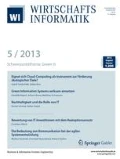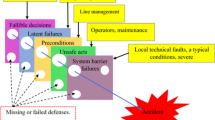Abstract
Tool support for professional credit-rating is currently dominated by data-oriented approaches. This results in primarily focusing on hard facts in the financial institutions’ process of evaluating credit inquiries of their customers. Content objects and arguments which cannot algorithmically be mapped onto rigid data-tables („soft facts”), however, with the potential of having a decisive impact on credit assessment, tend to be not sufficiently and appropriately placed into consideration. The BONITAS system overcomes this structural lack of information processing in traditional credit management systems in adding to the traditional approach innovative groupware-enabled capabilities. Compound documents in a messaging context are used to be integrative containers for all relevant information. These documents support both information gathering and evaluation of „hard” data and „soft” facts as well as semi-structured information gathering workflows allowing for a continuum of assessment-specific process options. The creation of valid and marketable business knowledge in credit management processes is basically team-driven. Thus, the essential features of groupware-based information management systems, i.e. their outstanding capabilities in communication, collaboration and coordination, represent critical baselines for improving the decision quality in credit-rating. An important goal of the BONITAS system is to aim at creating a constantly improved knowledge base on credit management workflows. This knowledge base is continuously being maintained in the operational progress of customer projects. It enables the financial institution to judge on the financial strength of upcoming clients in a holistic and anticipating evaluation process superior to traditional much more static assessments.
Similar content being viewed by others
Literatur
Dierker, Markus; Sander, Martin: Lotus Notes 4.6 und Domino — Integration von Groupware und Internet. Addison-Wesley, Bonn et al. 1999.
Espresso Systemdokumentation. Pavone Informationssysteme GmbH, Paderborn 2001.
EIS Systemdokumentation. Pavone Informationssysteme GmbH, Paderborn 2001.
Ewe, Jochen: Konto 3000 eröffnet neue Perspektiven. In: Deutscher Sparkassen- und Giroverband e.V. (Hrsg.): Betriebswirtschaftliche Blätter 49 (2000) 7, S.330–332.
Fell, Markus: Kreditwürdigkeitsprüfung mittelständischer Unternehmen: Entwicklung eines neuen Ansatzes auf der Basis von Erfolgsfaktoren. Gabler Verlag, Deutscher Universitäts-Verlag, Wiesbaden 1994, S.3.
Handelsblatt (o.V.): Die Risikostrukturen haben sich verschoben. Fundierte und qualifizierte Bonitätsprüfung vornehmen. In: Handelsblatt vom 17.4.1997, S. b14, Düsseldorf 1997.
Haase, Paul-Gerhard: Finanzservices in verteilten Umgebungen groupware-basierter Informationsmanagementsysteme — Konzept eines prozessorientierten Bonitätsmanagement-Systems. http://ubdata.uni-paderborn.de/ediss/05/2000/haase/index.htm, 2000-02, Abruf am 2001-08-08.
Hasenkamp, Ulrich et al.: Notes/Domino effektiv nutzen; Groupware in Fallstudien. Addison-Wesley, München 2000, S. 21.
Haberstock, Philipp; Nastansky, Ludwig: Konzeption eines prozessorientierten Team-Controllingsystems (ProTeCos) mit Groupwarebasierten fachlichen Komponenten. In: WIRTSCHAFTSINFORMATIK 41 (1999) 1, S. 20–30.
IBM Corporation, International Technical Support Organization: Lotus Solutions for the Enterprise, Volume 4 Lotus Notes and the MQSeries Enterprise Integrator. IBM Redbooks 1997-10-20.
Nastansky, Ludwig: Message-Objekte und Team-Kommunikation — Systembausteine für die Unternehmensführung in neuen Organisationsformen. In: Laux, Helmut; Franke, Günter (Hrsg.): Unternehmensführung und Kapitalmarkt. Springer, Berlin et al. 1998, S. 176–211.
Nastansky, Ludwig: Message-Objekte und Team-Kommunikation — Systembausteine für die Unternehmensführung in neuen Organisationsformen. In: Laux, Helmut; Franke, Günter (Hrsg.): Unternehmensführung und Kapitalmarkt. Springer, Berlin et al. 1998, S. 201.
Graf von Reventlow, Iven: Neue Wege in der Bonitätsprüfung; Das Kreditgespräch als Instrument zur Beurteilung der Unternehmerpersönlichkeit. Verlag Wissenschaft & Praxis Dr. Brauner GmbH, Ludwigsburg 1992, S. 31.
Sperber, Herbert; Mühlenbruch, Markus: Die Praxis der Bonitätsanalyse. In: Die Bank (1995) 4, S. 202.
Uthoff, Carsten: Erfolgsoptimale Kreditwürdigkeitsprüfung auf der Basis von Jahresabschlüssen und Wirtschaftsauskünften mit Künstlichen Neuronalen Netzen. Metzler, Stuttgart 1997.
Schindler, Martin: Wissensmanagement in der Projektabwicklung: Grundlagen, Determinanten und Gestaltungskonzepte eines ganzheitlichen Projektwissensmanagements. Eul-Verlag, Lohmar, Köln 2000, S. 39.
Weinrich, Günter: Das Bilanzportfolio — ein zukunftsorientiertes Analyseinstrument. In: Die Bank (1995) 7, S. 394–396.
Author information
Authors and Affiliations
Corresponding author
Rights and permissions
About this article
Cite this article
Haase, PG., Nastansky, L. Das BONITAS-System. Wirtschaftsinf 44, 65–73 (2002). https://doi.org/10.1007/BF03251466
Issue Date:
DOI: https://doi.org/10.1007/BF03251466




